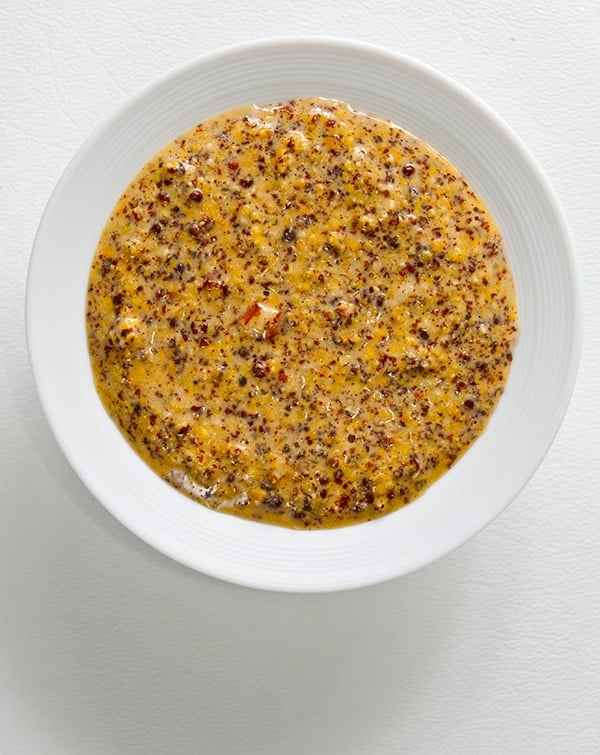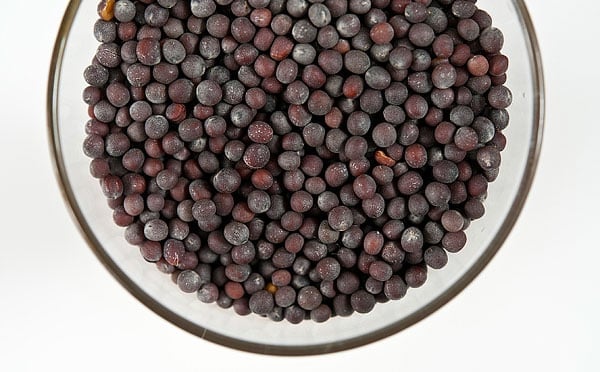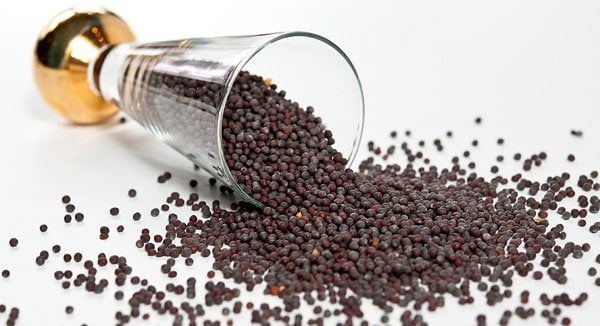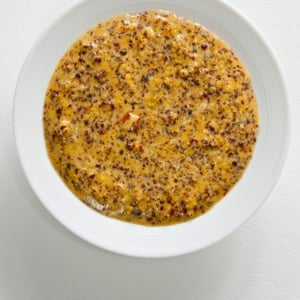As an Amazon Associate I earn from qualifying purchases.

What do you mean you can make mustard at home? It was all I could do not to say, “Uh… how did you think it was made? By mustard elves under a tree?” Instead, I said, “Why yes, and it is really, really easy to make.”
I had this conversation years ago with another food blogger, and I tell you this because for even a food person to not know how to make mustard tells me that it must appear to be magic to most people. But it ain’t. If you have mustard seed and water, you can make mustard.
It’s that easy. And pretty much every culture in the Northern Hemisphere has done so: Mustard is to the North what chiles are to the tropics.
Mustard is a condiment of a thousand faces. Some are smooth, others almost entirely made from barely cracked seeds. Vinegar is often used, but wine, beer, grape must, and even fruit juices are used to moisten the seeds.
Sweetness is usually achieved by adding honey; an American “honey mustard” can be a 1:1 ratio of mustard to honey. A Bavarian sweet mustard, however, uses only sugar and water: no acid, no honey. Italians put fruit preserves in their mustard.
Mustard is one of Europe’s few native spices, although it also has been used in Chinese cooking for around 2,500 years as well. Ancient Rome was quite the hotbed of mustard-making, and it is Rome that gives us our name for mustard: It is a contraction of mustum ardens, or “hot must;” the Romans often added crushed mustard seeds to unfermented crushed grapes.
I’ve recreated a Roman recipe for mustard that uses almonds, pine nuts, mustard seed and red wine vinegar.
The basic idea behind making mustard is this: Grind seeds and add liquid. At its most basic, this is all mustard is. Both Chinese and English mustard (think Coleman’s) is nothing more than water and mustard powder. But there are some things you need to know to make great mustard.
First, you need cold liquid. What gives mustard its bite is a chemical inside the seeds reacting with cool or cold liquid. You also need to break the seeds to get at the fiery chemical — it’s like cutting an onion. Heat damages this reaction, however, so to make a hot mustard use cold water, and warm water for a more mellow mustard.
Mustard sauces lose punch when long-cooked, and should always have a little extra fresh mustard tossed in at the end of cooking.
This reaction is volatile, too. Left alone, your mustard will lose its bite in a few days, or in some cases even hours. But adding an acid, most often vinegar, sets the reaction in place — this is what happens with horseradish as well. Adding salt not only improves the flavor, but also helps preserve the mustard, too.
If you skip the vinegar and salt, you will still have mustard, but it will not keep for long. Not that it will go bad, but it will lose it’s flavor.
Once made with salt and vinegar, mustard is nearly invulnerable to deterioration. Mustard is one of the more powerful anti-microbial plants we know of, and, considering it is mixed with vinegar and salt, it becomes a heady mix no wee beastie can survive in. It is said that mustard will never go bad, although it can dry out.
You have three choices when it comes to which variety of mustard seed you use: White, brown and black. White mustard undergoes a different, milder reaction than do brown mustard or black mustard, which are far zingier. American yellow mustard is made with white mustard seed and turmeric, brown mustards are in most of your better mustards, and black mustard is used in hot mustards or in Indian cuisine.
(Note: You can tame black and brown mustard seeds by soaking them in water overnight before grinding.)

Incidentally, the wild mustard all over California is black mustard. You can thank Father Junipero Serra for that one: He used mustard, which grows like a weed, to mark his travels in Alta California 250 years ago.
The famous Grey Poupon mustard — Dijon has been a center of mustard-making for nearly a millennium now — is traditionally made with stone ground brown mustard and verjus, the tart juice of unripe grapes. I prefer this style of mustard, and most of my homemade mustards are grainy like Dijon. I grind my seeds with a spice grinder, but you could get all old school and use a mortar and pestle.
The best mustards, in my opinion, combine brown or black mustard seeds with yellow mustard powder: The two sets of chemical reactions complement each other and made a more complex mustard.
Always add water or a non-acidic liquid first, let the mixture sit for 10 minutes or so, then add the acid (vinegar, verjus, lemon juice, etc).
Add salt to taste, but it’s typically about 1 to 2 teaspoons per cup of prepared mustard.

Finally, let your mustard set in the fridge or in a cool place for at least a day before you serve it. Bitterness is a byproduct of the mustard reaction, but that bitterness fades after a day or so. Pure mustards can be kept at room temperature, but mustards with other ingredients, like the Roman nut mustard I mention above, should be kept in the fridge.
So there you have it. Easy-peasy. Now you really have no reason to ever buy mustard again.
Basic Country Mustard
Ingredients
- 6 tablespoons mustard seeds, about 50 grams
- 1/2 cup mustard powder, about 50 grams
- 1/2 cup water or beer
- 3 tablespoons vinegar (cider white wine or sherry)
- 2 teaspoons salt, about 5 grams
- 1 teaspoon ground turmeric (optional)
- 2 tablespoons honey (optional)
- 1/4 cup minced fresh herbs (optional)
Instructions
- Grind the whole mustard seeds for a few seconds in a spice or coffee grinder, or by hand with a mortar and pestle. You want them mostly whole because you are using mustard powder, too.
- Pour the semi-ground seeds into a bowl and add the salt and mustard powder. If using, add one of the optional ingredients, too.
- Pour in the water or beer, then stir well. When everything is incorporated, let this sit for up to 10 minutes. The longer you let it sit, the mellower the mustard will be. When you’re ready, pour in the vinegar.
- Pour into a glass jar and store in the fridge. It will be runny at first. Don’t worry, it will thicken up overnight. Wait at least 12 hours before using. Mustard made this way will last a year in the fridge.
Video
Notes
- Change the liquid and you change the mustard.
- Grind the mustard seeds a lot or a little and you change the texture — or skip the whole seeds altogether and use just mustard powder. Or skip the powder and just use seeds.
- Want herbs in there? Go for it.
- Like honey mustard? Pour some honey in.
- Want your mustard even spicier? Add chiles or freshly grated horseradish.
Nutrition
Nutrition information is automatically calculated, so should only be used as an approximation.






Thanks for the useful information. I was wondering if the shelf-life of a mustard would change depending on additions? I made some elderberry vinegar and would like to try to concoct some elderberry mustard. If it works out, I might make some as gifts and would like to know how long it could keep (and if I can make it in advance!).
This is the elderberry vinegar recipe I used, if that’s helpful. https://www.food.com/recipe/elderberry-vinegar-255163
So, Hank……
You said there is no need to can the mustard, but if you wanted to put it on a shelf as opposed to the frig, is this mustard stable enough to do that?
Great post! You explained the process very well, and now that I understand it I have been able to make some delicious mustards.
I want to make mustard with fruit. I had a great fig mustard with balsamic vinegar at a German deli the other day. I’d like to try that. Is it best to use dried fruit or can I use some canned pears? And how will it affect it’s shelf life? Recipes are always welcome.
Thanks for the post. I’m new to the idea of making my own mustard as well.
Great tutorial! I was hoping someone before me had the idea to make mustard at home and tell us how to do it. I’m excited to try this! Thank you for sharing.
Just the explanation I was looking for. I can’t wait.
What do you think about hot-water canning the mustard? (So you can send through the mail to friends.) Let it sit in the fridge for a couple days before canning?
Rachel: No need to “can” mustard, as it never goes bad. Just hand-tighten the screw caps to your jars and you should be fine.
This is awesome! I love making mustard, but I have to say I loved reading this post almost as much. First time reader, and new fan! I’m going to be blogging about three basic dijons and I’ll be referencing this post! Love it.
I bought an amazing basil mustard in France last year and now I have the confidence to try duplicating it. Huzzah!
Hi Hank,
Thank you so much for the “basic recipe” and all the customized suggestions. I especially enjoyed learning about the types of mustard seed. Are there recommendations on the locations where the mustard seeds are grown? Does the climate affect the depth of flavor in the seeds?
This was a great little read. I’m purchasing my seeds today!
Sincerely,
Brenda
Great recipe! I am using my phone per your request, So far, so good! Typeset is very small…
If you’re looking for bulk mustard seed at ridiculously cheap prices, go to an Indian grocery store. Mustard seed is used liberally in their cooking, and you can buy big fresh bags for next to nothing. Great for other spices too, as well as various dried beans, basmati rice, and other interesting things.
Great recipe! Easy to follow and hopefully will turn out well! Thanks hank!
Where can you buy the mustard seeds?
Bonnie: Most supermarkets in the spice aisle, or online.
I like making violet mustard for wild game meats. I also like to add some cinnamon and clove.
I highly recommend making your own mustard, I probably have 4-5 different variations in my fridge right now, and I almost never make it the same way. Way better (and much cheaper) than store bought. Garlic, wine, fresh ground horseradish are all recommended!
My aunt uses milk as the liquid.
Very useful post! But can you explain why Coleman’s makes this monstrosity? https://www.colmans.co.uk/products/english-mustard-tube. We made the mistake of buying during a trip to Scotland many years ago and oh boy, nasty harsh stuff that was, tasted like just mustard powder and water. NOT a good thing on sandwichs, made my hubby cry!
Hank
Thanks for that.
I would echo the prior post of roasting the seeds, but also, if I wanted to use dried herbs how would you manage that? I have some really good Herbes de Provence and other mixtures from Penzy’s that might be good, but, of course, they’re dried, and I couldn’t replicate them all from my garden.
Thanks. Fun as always
Hank, great post. Who woulda thunk making mustard is so easy! I made a batch similar to your recipe. It was so hot the first couple of days I served it with shrimp & cocktail sauce, like Chinese hot mustard. After 2 weeks it changed and mellowed a lot. It seems like the flavor and style can be adjusted by using different ratios of the types of mustard seed & liquid to create any style of mustard one could imagine.
Never going to buy mustard at the store again!
Hank,
Great post. I’ve been meaning to do this for some time, and this is the most complete write-up I’ve seen. Thanks for that!
Does roasting the seeds before grinding impart any additional flavor?